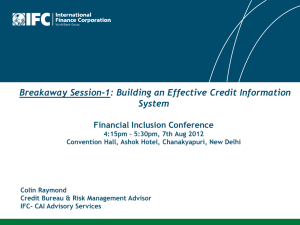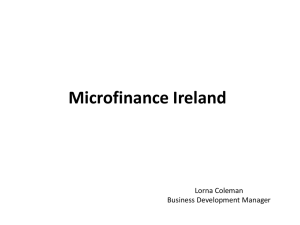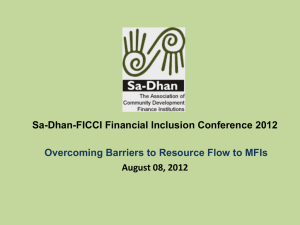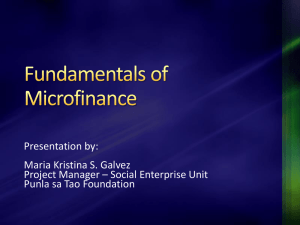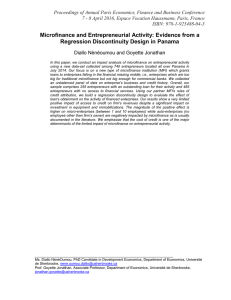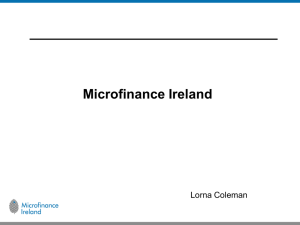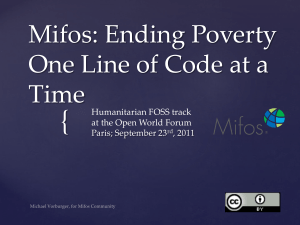Proceedings of Annual South Africa Business Research Conference
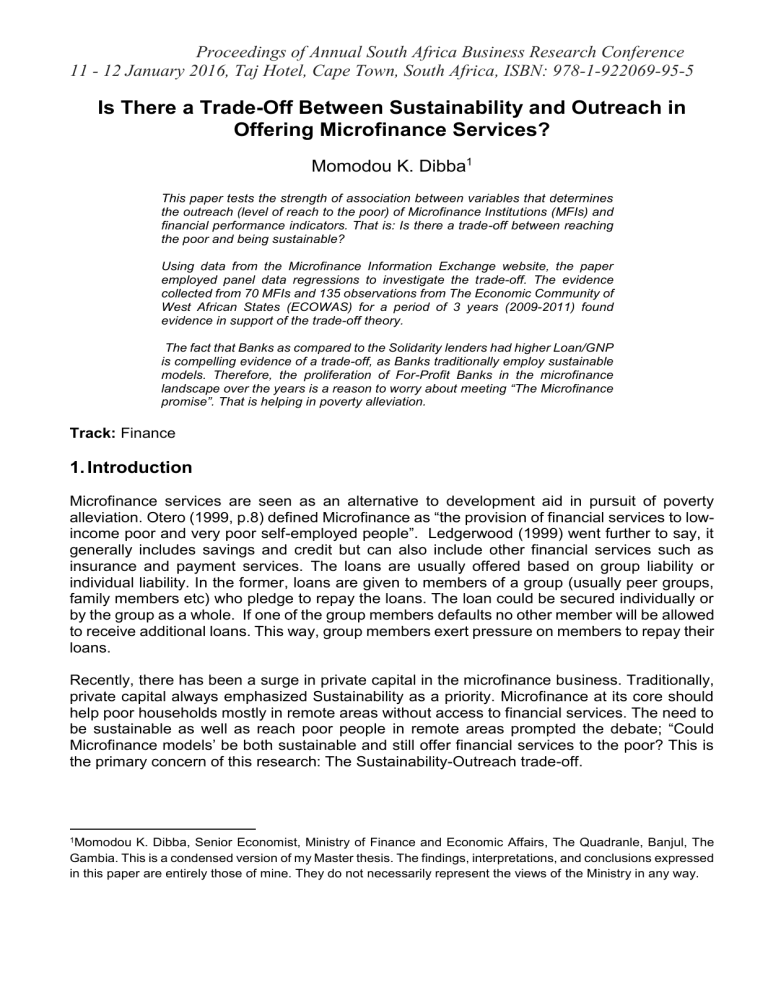
Proceedings of Annual South Africa Business Research Conference
11 - 12 January 2016, Taj Hotel, Cape Town, South Africa, ISBN: 978-1-922069-95-5
Is There a Trade-Off Between Sustainability and Outreach in
Offering Microfinance Services?
Momodou K. Dibba
1
This paper tests the strength of association between variables that determines the outreach (level of reach to the poor) of Microfinance Institutions (MFIs) and financial performance indicators. That is: Is there a trade-off between reaching the poor and being sustainable?
Using data from the Microfinance Information Exchange website, the paper employed panel data regressions to investigate the trade-off. The evidence collected from 70 MFIs and 135 observations from The Economic Community of
West African States (ECOWAS) for a period of 3 years (2009-2011) found evidence in support of the trade-off theory.
The fact that Banks as compared to the Solidarity lenders had higher Loan/GNP is compelling evidence of a trade-off, as Banks traditionally employ sustainable models. Therefore, the proliferation of For-Profit Banks in the microfinance landscape over the years is a reason to worry about meeting “The Microfinance promise”. That is helping in poverty alleviation.
Track: Finance
1. Introduction
Microfinance services are seen as an alternative to development aid in pursuit of poverty alleviation. Otero (1999, p.8) defined Microfinance as “the provision of financial services to lowincome poor and very poor selfemployed people”. Ledgerwood (1999) went further to say, it generally includes savings and credit but can also include other financial services such as insurance and payment services. The loans are usually offered based on group liability or individual liability. In the former, loans are given to members of a group (usually peer groups, family members etc) who pledge to repay the loans. The loan could be secured individually or by the group as a whole. If one of the group members defaults no other member will be allowed to receive additional loans. This way, group members exert pressure on members to repay their loans.
Recently, there has been a surge in private capital in the microfinance business. Traditionally, private capital always emphasized Sustainability as a priority. Microfinance at its core should help poor households mostly in remote areas without access to financial services. The need to be sustainable as well as reach poor people in remote areas prompted the debate; “Could
Microfinance models’ be both sustainable and still offer financial services to the poor? This is the primary concern of this research: The Sustainability-Outreach trade-off.
1 Momodou K. Dibba, Senior Economist, Ministry of Finance and Economic Affairs, The Quadranle, Banjul, The
Gambia. This is a condensed version of my Master thesis. The findings, interpretations, and conclusions expressed in this paper are entirely those of mine. They do not necessarily represent the views of the Ministry in any way.
Proceedings of Annual South Africa Business Research Conference
11 - 12 January 2016, Taj Hotel, Cape Town, South Africa, ISBN: 978-1-922069-95-5
Using data collected on 70 microfinance institutions (MFIs) and 135 observations across the
Economic Community of West African states for a period of 3 years (2009-2011) using an unbalanced panel data regressions. I found that Institutional design proves to be key to show potential trade-off.
Further, Banks have higher loans/GNP as compared to the Solidarity lenders (Non-
Governmental Organisations abbreviated NGOs and Cooperatives in our sample). As the size of a loan proxies the level of outreach in microfinance theory, this is an indication that banks
(offering microfinance services) have less reach than NGOs and Cooperatives. As Banks usually ensure sustainable models, this points to a potential trade-off between the two.
The capital cost (that is expenses on Rent +transportation +depreciation + office + other) does not have any significant relationship with sustainability. Labour cost (personnel expenses) was found to be negatively related to profitability.
The fact that Banks have higher Loan/GNP as compared to Solidarity lenders supports the view that there is a trade-off between outreach and sustainability. Therefore, the proliferation of private capital (examples Bank Compartamos of Mexico and Citigroup’s microfinance division) with the sole intent of profit making in the microfinance industry over the years is a reason to worry about me eting “The Microfinance Promise”. That is helping in poverty alleviation. This is reason why Muhammed Yunus and Grameen Bank were awarded the Nobel Peace Prize. In the words of the Prize committee “for their efforts through microcredit to create economic and social development from below”
This research will investigate the trade-off concern in West Africa. The only research with results relevant to Africa (East Africa to be specific) on this subject was Makame and Murinde (2006) to evaluate how outreach and sustainability is explained by commercialisation. Their results showed a trade-off between outreach and sustainability. Thus, to the best of my knowledge, I will be the first to test this in the West Africa region.
2. LITERATURE REVIEW
This paper contributes to the literature of offering microfinance services at a reasonable cost to beneficiaries as well as sustainability prospects of the lenders. A number of studies have raised concern on the high cost of small loans: Hume and Mosley (1996), Conning (1999),
Proceedings of Annual South Africa Business Research Conference
11 - 12 January 2016, Taj Hotel, Cape Town, South Africa, ISBN: 978-1-922069-95-5
Paxton and Cuevas (2002), and Lapenu and Zeller (2001). The above mentioned studies have shown that there exists evidence on the high cost of extending credit to the very poor. However, what divides opinion is how the cost of that lending and borrowing to the poor is to be borne?
Montgomery and Weiss (2005), provide evidence that showed there is a trade-off between outreach and Sustainability. They studied the microfinance landscape in Asia and latin
America.
Contrary to the above findings, Christen (2001) studied microfinance landscape in Latin
America. He found that commercialization has been synonymous with
Profitability/sustainability for MFIs in Latin America. He went further to explain that, with commercialization, most MFIs became regulated. And regulation, he argued, requires set minimum standards by regulatory authorities to ensure sustainability.
Following Christen (2001) contrary results on the direct or indirect impact of competition on outreach was uncovered by Navajas et al (2003) : that core poor were marginalised with the intense competition as loan contracts became more individualised and targeted the moderate poor. Similar results were uncovered by Olivares and Polanco (2005); Makame and Murinde
(2006); Hermes et al (2008); and Assefa et al (2010).
Further evidence comes from Cull et al (2007) to support trade-off existence. In their research, using average loan as an indication of level of outreach, they found that of the three categories of MFIs: Village banks, Group lenders, and individual lenders (mostly banks), the village banks served the core poor and women mostly. It is important to note here that village banks receive more subsidy than the other categories. Therefore, this supports the view that in order to improve outreach, MFIs will need some kind of subsidy.
3. THEORECTICAL FRAMEWORKS
Microfinance emerged as a result of the void left by the formal banking sector in reaching the poor of society in mostly remote areas. Thus, in microfinance theory, outreach refers to the ability of MFIs to reach the financially excluded section of society. Depth of outreach refers to
Proceedings of Annual South Africa Business Research Conference
11 - 12 January 2016, Taj Hotel, Cape Town, South Africa, ISBN: 978-1-922069-95-5 the ability to reach the poorest of society while the breadth refers to the number of poor clients an MFI has on its books. Outreach could therefore be viewed from two angles, which are depth and breadth of outreach.
Sustainability refers to the ability of microfinance Institutions to serve the poor without relying on subsidies. One of the supposed advantages of microfinance as opposed to development aid is that, it is often argued that it can pay for itself. That is MFIs can run sustainable models to deliver financial services to the poor.
Average loan Size has been used to show the depth of outreach. This has been primarily because it is argued there is no demographic data on clients to measure poverty levels. It is hypothesized that the poorer a client is, the less amount he/she demands in loans.
In this study, similar to Makame and Murinde (2006) and Cull et al (2007) average loan has been deflated by GDP per capita and 20% of GDP per Capita as more representative of the
Poor ’s share in the National output.
Number of clients (or active borrowers as used in this study) is used as breadth of outreach in microfinance theory. The more cust omers it has the larger an MFI’s breadth of outreach.
Percent of women borrowers-The number of women borrowers is often used as a sign of access to the poor. In this study, as in Cull et al (2007), we used it as a proxy to determine the level of access to the poor by an MFI.
3.1 Dependent Variables-
Operational Self-sustainability(OSS) - Operating revenue / (Financial expense + loan loss
Provision expense + operating expense). It indicates the MFI’s ability to operate without subsidy and without drawing down capital to pay for operating expenses (Cull et al , 2007). And unlike the FSS, the OSS is not adjusted financial data.
Return on Assets(ROA) : - Adjusted net operating income after taxes / Average total assets
Efficiency : - Com puted as operating expense divided by the period’s gross loan portfolio. All prices are taken at year ends and adjusted to 2000 constant prices.
Proceedings of Annual South Africa Business Research Conference
11 - 12 January 2016, Taj Hotel, Cape Town, South Africa, ISBN: 978-1-922069-95-5
All three above do not emphasize profitability by MFIs but at least, will be able to show if all required cost are covered. That is break-even points will be determined in the worst-case scenario.
In this research, we categorized all NGOS and cooperatives as Solidarity lenders. They employ lending based on group liabilities, whilst Banks and Non-Bank Financial Institutions (NBFIs) represent the individual lending style.
3.2 Definition of Independent Variables:
Real Yield measures the yield on the gross loan portfolio of the MFI.
The Capital Asset ration depicts the ratio of the capital stock of the MFI to its asset holdings. This is used as a measure of the banks Sustainability. A higher figure indicates more sustainability; hence a positive sign is always good.
Labour cost inclusion is indicative of the productivity of labour. This is the labour to asset ratio
The size of an MFI is included to test whether the size of an MFI has any bearing on the sustainability of the lender. Further it test the “claim” big MFIs exhibit economies of scale and or big MFIs may show little interest in offering microfinance services to the poor people. The MFIs are categorized as small(less the USD $500,000) loan portfolio, medium ( >USD $ 1m) and large (> USD $10m).
The concern that For-Profit institutions focus more on profitability justified the inclusion of the profit status of MFIs in the regressions as a dichotomous variable, where a digit of 1 indicates if an MFI was set up to make profit , and zero(0) otherwise. It does not mean the MFI registered a profit in its operations. For example, NGOs and
Cooperatives do not have profit earning as their primary objective but banks offering microfinance services do strive for profit. I test if this has an impact on the level of outreach of the MFI as well as its sustainability.
Christen (2001) argued that, as MFIs age, they do not necessarily switch to richer clients but alter the loan contracts to suit the needs of the customers they already have on their books. That is to say, the age of an MFI does have a bearing on contract
Proceedings of Annual South Africa Business Research
Conference
11 - 12 January 2016, Taj Hotel, Cape Town, South Africa, ISBN: 978-1-
922069-95-5 design, which in effect also has bearing on outreach and its scale. Do older MFIs tend to serve medium poor or do they achieve so much experience to administer microfinance services with reduce cost on a larger scale? The “log_age” independent variable tests the strength of this assumption.
4. ECONOMETRIC ANALYSIS
4.1 The Data and Methodology
With data on 70 microfinance institutions and 135 observations across ECOWAS for a period of 3 years using an unbalanced panel data, I investigate this. The data was obtained from the Microfinance Information Exchange (MIX) Market website. The institutions have been picked largely on data quality. All institutions below a three star rating on data quality by the MIX Market were dropped. Further, institutions were categorized into sizes.
There are two parts to the regressions:
In the first model, all three measures of Sustainability were used as dependent variables to test the strength of association with key independent variables. The independent variables are: Interest rates, Labour cost, Capital cost, Size of an MFI,
Legal status of the MFI and Percent of women borrowers.
On the second part, to check specific relationship between Sustainability with interest rates, labour cost and capital cost of MFIs, I categorised them into three as in above but with a deliberate choice to now represent MFItype1 as Solidarity lenders, MFItype
2 for Non-Bank Financial Institutions(NBFIs) and MFItype 3 for Banks. I made this distinction to separate the interaction effects from the overall effects of the legal status as outlined in the above paragraph. The motive being to check how interest rates, labour cost and capital cost varies moving from being a solidarity lender to individual lending style.
Proceedings of Annual South Africa Business Research
Conference
11 - 12 January 2016, Taj Hotel, Cape Town, South Africa, ISBN: 978-1-
922069-95-5
5.
MAIN RESULTS
The table below gives the correlation matrix of all the variables used in the regression.
The main Sustainability indicators of OSS and ROA are positively related but adversely related to efficiency.
Table 1 Correlation Matrix- Key Variables
. corr oss roa avloangni rgy capassets lassets avloan wborrowers portfolioatris
> k efficiency age costborr borrowers personel
(obs=122)
oss roa avloan~i rgy capass~s lassets avloan
oss 1.0000
roa 0.7584 1.0000
avloangni -0.0108 0.0043 1.0000
rgy -0.0615 -0.0526 0.0119 1.0000
capassets 0.3850 0.5383 0.0171 -0.2473 1.0000
lassets -0.3337 -0.4846 0.0415 0.5693 -0.4189 1.0000
avloan 0.0326 -0.0752 -0.0592 -0.0467 -0.1807 -0.0057 1.0000
wborrowers -0.0340 0.0670 -0.1458 0.1185 0.2607 0.1215 -0.5033
portfolioa~k 0.0463 0.0536 -0.0284 0.1568 0.0238 0.0447 -0.1210
efficiency -0.4163 -0.5395 0.0193 0.5933 -0.5060 0.9232 0.0634
age 0.0476 0.0270 0.1379 -0.0382 -0.0493 -0.2033 0.1986
costborr -0.2749 -0.4444 -0.0223 0.3937 -0.5133 0.7235 0.4349
borrowers 0.2436 0.2156 0.1056 0.1037 -0.0958 -0.1040 -0.0302
personel 0.1778 0.1748 0.0006 0.2682 -0.1616 -0.0610 0.1879
wborro~s portfo~k effici~y age costborr borrow~s personel
wborrowers 1.0000
portfolioa~k 0.1280 1.0000
efficiency 0.0528 0.0346 1.0000
age -0.3143 0.0346 -0.2200 1.0000
costborr -0.1902 -0.0360 0.8487 -0.1352 1.0000
borrowers -0.0034 0.2225 -0.1379 0.4135 -0.1340 1.0000
personel -0.1980 0.0176 -0.0630 0.5264 -0.0369 0.7950 1.0000
.
For the Outreach indicators average loan which is used as a proxy for level of outreach is negatively related to: percent of women borrowers and number of borrowers.
Table 2 has the summary statistics. On the financial indicators, it is often argued by
Microfinance theory that banks do well on all these indicators compared to their counterparts in Solidarity lenders and Non-Bank Financial Institutions to a lesser degree. This is true for all the variables used as financial performance indicators as shown below in table 2.
There are mix results for the basic statistics on outreach indicators. For example, as smaller loans tend to be associated with Solidarity lenders, on the surface i did not find that solidarity lenders have the smallest loans relative to others as they have the
Proceedings of Annual South Africa Business Research
Conference
11 - 12 January 2016, Taj Hotel, Cape Town, South Africa, ISBN: 978-1-
922069-95-5 highest Average loan (654.4203). But, as in Cull et al (2007) , due to the fact that loan sizes are measured in local currencies and valued at existing exchange rates, it can substantially distort the purchasing power of a given amount of currency differences.
Thus, this may not be an ideal indicator hence the use of the Average loan/GNI per caipta to deflate in order to allow international comparison. When deflated, the results follow theory as the Banks have the highest at 21.
On the cost per borrower figures, both solidarity lenders (NGOs and Cooperatives) have the lowest cost per borrower among the lenders. Could this be because they are often located closest to clients? A question left for further research. NBFI having a higher cost per borrower compared to banks is in line with what theory predicts
Table 2 Summary Statistics per MFI Type
Variables/MFIType Solidarity
Lenders
Banks
Operational
Sufficiency
Self1.079325 1.247817
Non Bank Financial
Institution(NBFI)
1.001370588
Return on Assets -0.02065
Average Loan/GNIP 0.976647
Real Gross Yield 0.210292
Capital /Assets ratio 0.226325
0.104633
21.086
0.401225
0.417717
-0.0065
0.948358824
0.318147
0.376329
Labour/Assets ratio
Average Loan
Percent
Borrowers
0.09378
654.4203
Women 0.637762
0.189145
522.5391
0.584245
0.101259
543.2653
0.701329
Proceedings of Annual South Africa Business Research
Conference
11 - 12 January 2016, Taj Hotel, Cape Town, South Africa, ISBN: 978-1-
922069-95-5
Portfolio at 5.089089 0.204708 0.0747
Risk>30days
Efficiency
Cost per Borrower
0.309821
195.2247
# of Active Borrowers 28264.96
Personnel 207.6981
0.460825
235.2588
53379.5
426.833
0.434829
261.4367
25998.82
231.8235
5.1 Panel Regressions
In the Panel Regression output in Table 3 below, the results show that increasing interest rates (coefficient of rgy) is associated with improved sustainability for all three indicators. This is in line with the findings of Cull et al . The same result applies when it is disaggregated into lending style. It is important to note that, MFI 1 was removed and hence used as the reference group. The coefficient for rgymfitype2 and rgymfitype3 are the difference between them and solidarity lending style MFIs.
On Labour cost, there is an inverse relationship with OSS and ROA but it is not significant as revealed by the significant test. Further disaggregated into lending style, there still remains a negative relationship. This is in sharp contrast with the Cull et al
(2007) study where labour cost was associated with improved performance. They hypothesized that, more effort was needed to identify credit worthy customers who make better clients in the future. This is in contrast to what I found. Nonetheless, I would like to subscribe to their theory. Most of their select banks were much focused on financial performance; it made sure labour cost was well spent on identifying credit worthy customers while the same cannot be said of the banks in my study; that is cooperatives and NGOs which are focus more on poverty alleviation.
Proceedings of Annual South Africa Business Research
Conference
11 - 12 January 2016, Taj Hotel, Cape Town, South Africa, ISBN: 978-1-
922069-95-5
Table 3 Sustainability Regression
OSS ROA Efficiency
Coefficient P> Z Coefficient P> Z Coefficient P> Z
Rgy 0.4279934 0.06** 0.2329977 0.019* 0.0678292 rgymfitype2 0.9658477 0.187*** 0.151156 0.624*** 0.1556425 rgymfitype3 2.106759 0.019* 0.3009821 0.428*** -0.234639
Capassets 0.1073473 0.325*** 0.0383846 0.401*** 0.3022733
0.596***
0.704***
0.642***
0
Costmfitype2 1.828697 0.03* 1.737465 0 - 0.1864777 0.694***
Costmfitype3 -0.1838478 0.609*** 0.1050695 0.479*** 0.3828713
Lassets -0.9095927 0.003 -0.6841539 0 2.475533
0.057**
0 lbmfitype2 -5.770668 0.001 -1.391739 0.057** -0.2200935 0.824*** lbmfitype3 -4.258426 0.02* -0.7105991 0.378*** 1.399166 0.175*** legalstatus
2 1.13534 0.034* -0.2177697 0.323*** -0.2737395 0.361***
3
Mfisize
2
0.7780718 0.112*** 0.1558356 0.419*** -0.4047898 0.137***
-0.0721026 0.688*** -0.0965387 0.169*** - 0.1061996 0.286***
Proceedings of Annual South Africa Business Research
Conference
3
11 - 12 January 2016, Taj Hotel, Cape Town, South Africa, ISBN: 978-1-
922069-95-5
0.1230322 0.333*** 0.0138042 0.786*** -0.056787 0.422*** age_log 0.0760938 0.087** 0.0050535 0.806*** 0.0084703
1.profitst~s -1.130645 0.001 0.1672544 0.206*** 0.347787 wborrowers 0.1169118 0.254*** 0.1592419 0.001
_cons 1.060023 0 -0.103456
0.0816833
0.116*** 0.1102014
*significant at 1% **Signficant at 5% ***significant at 10%
0.736***
0.065**
0.158***
0.206***
Variables: OSS -Operatinal Self Sufficiency; ROA -Return on Assets; Efficiency;
Avloangni -Average loan ration to Gross National Income; Rgy-Real gross Yield;
Rgymfitype2-Real yield of MFI type 2; Capassest-Capital to asset ration;
Costmfitype2; Costmfitype3; Lassets-Labour to assets ratio; Lbmfitype2; Lbmfitype3;
Legalstatus 2; Legalstatus 3; Mfisize 2; Mfisize 3; Age_log- Log of age of MFI; Profit
Status; Wborrowers-percent of women borrowers
Capital cost in the Cull et al (2007) study was found to reduce profitability for individual based lenders. The same result was found for one of the individual lending style banks that is the NBFI (coefficient of costmfitype3-significant z-test across all 3 indicators) in the study here . But the same association did not exist for the Bankbased MFIs (coefficients of costmfitype2 across all 3 for two of the indicators) .
Further to that, their study did not find any significant relationship between Capital cost and solidarity lenders. In the regression outputs in table 3, similar results were obtained as the coefficient for Capassets(since MFI1 is not included this becomes the coefficient for solidarity lenders).
The coefficient of % of women borrowers shows a positive relationship with all three indicators. This does not suggest a trade-off between one of the variables of outreach and Sustainability.
5.2 Outreach Determinants Results
Proceedings of Annual South Africa Business Research
Conference
11 - 12 January 2016, Taj Hotel, Cape Town, South Africa, ISBN: 978-1-
922069-95-5
The results in Table 4 above is an attempt to shed light on what determines depth(average loan used as proxy) and breadth of outreach. Much of the output is not interesting and significant unless when data is disaggregated into lending style. The three average loan indicators have an inverse relationship when moving from
Solidarity bank to being a Bank and an NBFI coefficient ( legalstus 1 and 2). On the other hand, they showed a positive relationship with breadth of outreach.
The number of women borrowers’ interaction with mfitype produce negative relationship when average loan is deflated by GDP and 20% of GDP-to be more representative of the poorest. This points to a trade-off as it relates to the research question. In addition, it also shows an inverse relationship with breadth of outreach
(coefficient of active borrowers). The initial results have produced almost identical patterns with the Cull et al (2007) results, and that is: The Sustainability-Outreach trade-off only becomes apparent when data is disaggregated into lending style.
Table 4 Determinants of financial depth and breath
Average Loan_log Avloan/GDP_log Avloan/20%GDP Active Borrower_log
Coefficient P> Z Coefficient P> Z Coefficient P> Z Coefficient P>Z avloan_log n/a n/a 0.953629 0 0.953629 0 -0.43037 0.022*
-0.10358 0.664*** -0.10358 0.664**8 0.110095 0.82**8 Roa eff_log pers_log age_log
-0.94168 0.001
-1.09818 0
0.131487 0
-0.45243 0 costborr_log 0.852774 0
0.025478
-0.02265
0.12389
-0.05131
0.819***
0.528***
0.113***
0.477***
0.025478
-0.02265
0.12389
-0.05131
0.819***
0.528***
0.113***
0.477***
0.030037
0.845684
0.567816
-0.43013
0.928***
0
0.031**
0.031* legalstatus
2
3
-0.18734
-0.36417
0.561***
0.264***
-0.16117
-0.27591
0.629***
0.417**8
-0.16117
-0.27591
0.629***
0.417***
0.359818
0.772094
0.801***
0.452***
Wmfitype wmfitype3
_cons
0.214061 0.674*** -0.1869 0.72*** -0.1869 0.72*** -1.01288 0.646**8
0.410314 0.338*** 0.621406 0.156*** 0.621406 0.156*** -0.29904 0.791***
1.158201 0 -5.57405 0
Significant at 1% **Significant at 5% ***significant at 10%
-3.96462 0 8.205353 0
Proceedings of Annual South Africa Business Research
Conference
11 - 12 January 2016, Taj Hotel, Cape Town, South Africa, ISBN: 978-1-
922069-95-5
* AvloanGDPratio_log;- Log of Average Loan GDP ratio;AVloan20%GDP_log:- Log of
Average loan to 20% of GDP;Log ctive Borrowers:- The log of Active number of borrowers; Avloan-log: Log of Average Loan;ROA:- Return on Assets;
Eff_; log:- Log of efficiency;Pers_log:- log of number of personell working for the
MFI;Age_log:- Log of age of MFI; Costborr_log:- Log of average cost per borrower;Legal status:- Legal status of MFI; Wmfitype2:- Percent of women borrowers for MFI type 2;mfitype 3:- Percent of women borrowers for MFI type3
6. CONCLUSION AND DISCUSSION
6.1 Is Microfinance Double-Faced?
Based on evidence observed from 70 MFIs across the ECOWAS region, I found that banks involved in microfinance services had the highest Loan/GNI per capita on their books compared to the solidarity lenders. Furthermore, I also found out that solidarity lenders had the lowest cost per borrower. This seems strange as one would hypothesize that banks enjoy better economies of scale due to their large operations.
As earlier stated, this would be because most of the solidarity lenders are located in rural communities hence less cost of operations.
The cost structures of MFIs exhibit different result as compared to the Cull et al (2007) study. In their study, they found that most of the MFIs with higher labour cost were very profitable. The theory, as they hypothesized, is that higher effort was needed to screen potential customers who perform better as their credit worthiness is expected to be of higher standard thereafter. I conclude that, the different result is as a result of the composition of the sample. Their sample was very much focused on Institutions that had Profitability high on their agenda while the sample in this study was mainly cooperatives and NGOs (79%).
The only positive with respect to the trade-off debate was the percent of women borrowers. It does not show trade-off with Sustainability.
Proceedings of Annual South Africa Business Research
Conference
11 - 12 January 2016, Taj Hotel, Cape Town, South Africa, ISBN: 978-1-
922069-95-5
6.1.1 Discussion
I have been particularly impressed by an analogy by Elisabeth Rhyne in her essay
“The Yin and Yang of Microfinance: Reaching the Poor and Sustainability”. But, it also emphasized my concern on this trade-off debate. Do we have enough information on clients? Is Loan size, number of clients and percent of women borrowers enough to determine poverty level and scale of outreach?
She likened the microfinance problem to that of a mathematician with a dual maximization problem. A dual maximization problem would certainly have two objectives-reaching the poor and achieving Sustainability in our case. In this case, there is no one solution as she pointed out. One has to be treated as a constraint, while the other is maximized.
The mathematician’s solution is to derive a curve where the trade-off will be established. As she pointed out, the equivalent of this is the Production Possibility
Curve in economics. My concern is that, the current debate assumes we are on the curve and moving along the curve implies a trade-off. As she pointed out, we might, in fact, be inside the curve where more of both can be achieved. I found it troubling that, all researchers I read had nothing on the poverty levels of customers except the average loan size. There is probably more behind the average loan we need to dig into. This might help to throw more light on the debate. Consider this:
“MFI field operations have far surpassed the research capacity to analyze them, so excitement about the use of microfinance for poverty alleviation is not backed up with sound facts derived from rigorous research. Given the current state of
Knowledge, it is difficult to allocate confidently public resources to microfinance development. (Zeller and Meyer 2002)”
.
Over a decade later, we are still using proxies to determine level of poverty even in the academic literature.
Proceedings of Annual South Africa Business Research
Conference
11 - 12 January 2016, Taj Hotel, Cape Town, South Africa, ISBN: 978-1-
922069-95-5
Finally, I would like to emphasize that, unless we start to get actual poverty level indicators than the current proxies of Average loan, Number of clients and Percent of women borrowers, we are far from reaching some kind of progress in this debate. We need more demographic information on clients that the average size of the loans they take. It is well documented that poverty has many dimensions and how many of those might be lurking behind we don’t know. It will be educative to work more on this topic with more demographic information on clients. I do understand it is difficult to measure levels of poverty but I definitely think average size of a loan is too scanty to indicate poverty levels. With that added knowledge, we could argue if microfinance will be a viable option to poverty alleviation.
End Notes
1. In the countries selected Guinea Bissau was dropped obviously for poor data quality and Cape Verde had no MFI registered with the MIX Market as at the time of writing this report
2. Definitions for all Dependent variables were from the MIcroBanking
Bulletin(2005), p. 57
REFERENCES
Assefa et al 2010 Competition and Performance of Microfinance Institutions http://www.microfinancegateway.org/gm/document-
1.1.9499/competition%20and%20performance%20of20%mfis.pdf
Christen, R.P 2001 Commercialization and mission drift: The transformation of microfinance in Latin America , Occasional paper No. 5, Washington DC: CGAP,
2001.
Conning, J. 1999 Outreach, sustainability and leverage in monitored and peermonitored lending. Journal of Development Economics 60 (1), 51
—77
Proceedings of Annual South Africa Business Research
Conference
11 - 12 January 2016, Taj Hotel, Cape Town, South Africa, ISBN: 978-1-
922069-95-5
Cull, R., A. Demirguc-Kunt and J. Morduch 2007 “Financial performance and outreach: A global analysis of lending micro banks ”, Economic Journal, 117,
2007, F107-F133.
Hulme, D. and Mosley, P 1996.
Finance Against Poverty, Vol. 1 and 2, Routledge:
London. 1996
Lapenu, C. and Zeller, M 2001
“Distribution, growth and performance of microfinance institutions in Africa, Asia and Latin America , Food Consumption and Nutrition
Division Discussion Paper no.114, International Food Policy Research Institute.
June 2001.
Ledgerwood, J. 1999 Sustainable banking with the poor . Microfinance handbook,
World Bank, Washington D.C.
Makame, A.H. and V. Murinde 2006 Empirical findings on cognitive dissonance around microfinance outreach and sustainability, unpublished paper, Birmingham:
University of Birmingham, 2006.
MIX Market website is www.themixmarket.org
Montgomery H and Weiss J, 2005 “Great Expectations: Microfinance and Poverty
Reduction in Asia and Latin America” ADB Institute Research Paper Series No
63, February 2005.
Navajas, S., J. Conning and C. Gonzalez-Vega 2003 “Lending technologies, competition and consolidation in the market for microfin ance in Bolivia”, Journal of International Development, 15, 2003, pp. 747-770 .
Olivares-Polanco 2005.
“Commercializing Microfinance and Deepening
Outreach” Journal of Microfinance 7 (2) 47-70
Otero, M. 1999.
Bringing development back into microfinance. Latin America:
ACCION International.
Proceedings of Annual South Africa Business Research
Conference
11 - 12 January 2016, Taj Hotel, Cape Town, South Africa, ISBN: 978-1-
922069-95-5
Paxton, J. and C. Cuevas , 2002 “Outreach and sustainability of member-based rural financial intermediaries”, 2002, In: M. Zeller and R.L. Meyer (eds), The triangle of microfinance: Financial sustainability, outreach, and impact, Baltimore and
London: Johns Hopkins University Press.
Rhyne E (1998).
“The Yin and Yang of Microfinance: Reaching the Poor and Financial
Sustainability” The Microbanking Bulletin July 1998 pages 6-8
Zeller, M. and Meyer, R.L., 2002 “Improving the Performance of Microfinance: Financial
Sustainabilty, Outreach and Impact” in Zeller, M. and Meyer, R.L. (eds), The
Triangle of Microfinance: Financial Sustainabilty, Outreach and Impact, The
Johns Hopkins University Press, Baltimore, pp. 1-14
ANNEX
Table 5 Measurements, and definitions of Variables
Variable
Operational
Sufficiency
Returns on Assets
Self-
Definition
Operating revenue / (Financial expense + loan loss provision expense + operating expense)
Adjusted net operating income after taxes / Average total assets
Average Loan Size to GNI Age of the MFI in years
For Profit Status For-profit is 1, non-profit is 0.
Solidarity Lending The group takes responsibility in case of default as opposed to individual taking responsibility in Banks.
Traditional Banks with a Microfinance Division Banks
Non-Bank Financial Inst Financial Institutions without full Banking services like lower Capital requirement
Size of MfI indicator
Regulation
Size of the loan portfolio, which is 1 for small, 2 for Medium and 3 for large.
Whether the MFI is regulated or not
Proceedings of Annual South Africa Business Research
Conference
11 - 12 January 2016, Taj Hotel, Cape Town, South Africa, ISBN: 978-1-
922069-95-5
Real Gross Yield (Yield on gross portfolio (nominal) - Inflation rate) / (1+ Inflation rate)
Capital Cost to Asses
Labour Cost to Assests
Average Loan
(Rent + transportation + depreciation + office + other) / total assets
Personnel expenses/total assets
Average portfolio outstanding / by average number of active borrowers during the period( US dollars)
Women Borrowers
Portfolio at Risk
Efficiency
Percent of borrowers who are women
Loan Portfolio at risk at 30 days.
Computed as operating expense divided by the period’s gross loan
Age
Cost per Borrower
Active Borrowers
Personnel portfolio. All prices are taken at year ends and adjusted to 2000 constant prices
Age of the MFI in years
Unit cost of the MFI per borrower
Number of active borrowers
Number of Staff
Gross Domestic Product The Gross Domestic Product of the Country in which the MFI is located
